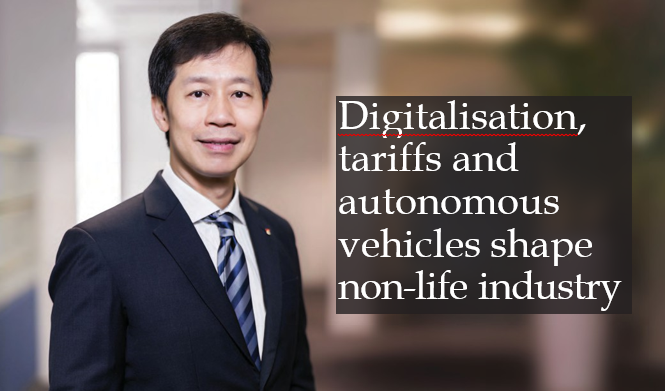Digitalisation, tariffs and autonomous vehicles shape non-life industry


04 Nov 2025
The following article was published in Asia Insurance Review on 1 November 2025.
The Singaporean non-life insurance industry is being shaped by a number of factors, including digitalisation, tariffs and the country’s push towards autonomous vehicles. While some impacts, like tariffs, may be temporary but significant, others like digitalisation and digital acceleration are here to stay, supported by initiatives from the regulator. We speak to MSIG Singapore’s Mr Mack Eng for more insights.
By Sarah Si

When he spoke with Asia Insurance Review, MSIG Singapore CEO Mack Eng highlighted two trends in Singapore’s non-life insurance industry over the past year, the impact of US tariffs on the country’s open economy, as well as “the increasing sophistication of cybercrime”.
Tackling cybercrime
According to the ‘Annual Scams and Cybercrime Brief 2024’, published by the Singapore Police Force, there has been a 10.8% increase in the number of scam and cybercrime cases in the country, from 50,376 in 2023 to 55,810 in 2024.
Mr Eng believes insurers can meet this surge in cybercrime taking place despite enhanced security measures by curating relevant insurance for corporates, citing a collaboration his company has with a cyber security service provider to offer holistic business protection.
Impact of US tariffs
Touching on US tariffs that subject countries to varying rates, Mr Eng indicated a triggered wave of “frontloading in cargo shipments, resulting in a temporary uplift”.
He said, “This will taper off in the second half of the year into 2026, giving way to a more cautious climate and a pullback of trading activities.”
In addition, due to the nature of Singapore’s open economy, Mr Eng pointed out that geopolitical developments have “an outsized impact on the local business environment and subsequently our industry”.
For instance, he said as trading partners face higher tariffs, local exporters, especially SMEs with primary focus on US market, will be the hardest hit.
“The ripple effects will be felt across sectors, from manufacturing to semi-conductors and electronics. Alongside this, there is increased capacity; both having direct impact on the industry,” he said.
“The crux of the matter is how insurers collaborate with intermediary partners to deliver value and service to clients in the current business climate.”
Challenges faced
“While Singapore’s general insurance market continues to grow steadily, it is facing increasing saturation due to high market penetration and intense competition”, said Mr Eng.
Although segments such as motor and property remain resilient, he also said that that “overall landscape is becoming more complex with geopolitical changes like the US tariffs that have a direct impact on businesses and the industry”.
InsurTech firms are also behind another shift in trends, according to Mr Eng. He said, “There is more collaboration as opposed to competition.”
However, he also noted the exceptions to the rule, such as platforms that secure insurance licenses and capitalise on their ecosystem for opportunities. In these cases, he said that “it can be seen as another competitor with a ‘natural hinterland’, like the banks”.
When asked how his company was responding to these developments, Mr Eng said it was “with measured approaches to remain relevant in the rapidly changing environment”.
“To support sustainable growth, we are driving innovation, agility and improved efficiencies,” he said.
“Whilst focusing on our core competencies and flagship offerings, we have also broadened our suite of solutions to serve both corporate clients and consumers.”
Adapting to digitalisation
As technology advances in the last five years have accelerated at an unprecedented pace, Mr Eng pointed out that “embracing, adapting and adopting the latest technology are on the minds of progressive insurers”.
“The question of optimising efficiencies, enhancing productivity and upskilling of talent are the foremost priorities,” he said.
“From underwriting to operations to customer service, these roles will be transformed in a manner not seen in the last few decades.”
In fact, he noted this digital-first approach has transformed their operations, “which has resulted in increased agility, scalability and overall competitiveness”.
“Our strategic investments in technology have delivered tangible results, including time savings of over 31,000 hours from automation initiatives last year,” he said.
Mr Eng also touched on his company’s testing and deployment of GenAI across functions such as customer service, marketing and recruitment over the past year as an example, Mr Eng called it “a catalyst for greater efficiencies and enhanced experiences for our stakeholders”.
“GenAI has proven its value across a range of high-impact use cases such as enhancing customer support and streamlining underwriting, to strengthening fraud detection and accelerating claims validation, some of which we have pilot tested and implemented to drive both efficiency and improved outcomes,” he said.
“These are early days and as technology continues its rapid evolution, the performance of these GenAI capabilities will continue to improve over time. With more advanced models being released, we will explore its uses for more business functions.”
Supportive regulations
Said Mr Eng, “Singapore’s regulatory framework balances oversight and agility, and has been supportive of the non-life industry through the Monetary Authority of Singapore’s Financial Services Industry Transformation Map (ITM).
“At its core, ITM promotes technology adoption, skills development, innovation and sustainability, which are vital to reshaping a future-ready insurance ecosystem.”
He also made sure to point out that the ITM provided insurers with a “structured pathway” to integrate GenAI responsibly.
“The ITM’s emphasis on workforce readiness is equally critical,” Mr Eng said, noting that through partnerships, initiatives and career conversion programmes, the MAS is equipping insurance professionals with the digital fluency and mindset needed to thrive in an AI-driven landscape.
“This also ensures that as insurers adopt advanced technologies, their workforce is prepared to manage the opportunities and risks that come with them,” he said.
Finally, Mr Eng highlighted other targeted initiatives like the Green Finance Action Plan, that promotes sustainable finance and green insurance, that complement the ITM.
He said, “This aligns insurers with national climate goals and encourages responsible innovation in environmental risk management.”
Looking ahead
When asked what trends and developments he expects in Singapore’s non-life insurance industry that over the coming year, Mr Eng was quick to say, “Singapore’s push towards autonomous vehicles is gaining momentum.
“Though widespread adoption may take time, this signals a clear trajectory and opens new frontiers for insurers to rethink product coverage and liability frameworks.”
He also highlighted the “transformative phase” digital acceleration is entering, led by the rapid rise of GenAI and agentic AI.
“These technologies are redefining the insurance landscape and are unlocking new dimensions for hyper personalisation, operational agility and elevated experiences,” he said.
“Their influence is expected to deepen, and the broader potential of these technologies will be actively tested and implemented when viable.”
As Singapore’s open economy makes it especially sensitive to global trade shifts, Mr Eng also believes tariff changes and geopolitical tensions may impact trading activities and affect business confidence in overseas expansions.
To address this, he suggested insurers enhance SME propositions to offer greater flexibility and value-driven coverages, with a primary focus on the service delivery across the value chain, much like his company is doing.
“As Singapore reinforces its stature as a regional insurance hub, demand for underwriting specialty lines will continue to grow,” he said, noting synergies can broaden offerings and present cross-sell opportunities that insurers like MSIG Singapore can leverage.
Said Mr Eng, “All these will present interesting opportunities and insights.”